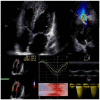Multimodality Imaging Assessment of Tetralogy of Fallot: From Diagnosis to Long-Term Follow-Up
- PMID: 38002838
- PMCID: PMC10670209
- DOI: 10.3390/children10111747
Multimodality Imaging Assessment of Tetralogy of Fallot: From Diagnosis to Long-Term Follow-Up
Abstract
Tetralogy of Fallot (TOF) is the most common complex congenital heart disease with long-term survivors, demanding serial monitoring of the possible complications that can be encountered from the diagnosis to long-term follow-up. Cardiovascular imaging is key in the diagnosis and serial assessment of TOF patients, guiding patients' management and providing prognostic information. Thorough knowledge of the pathophysiology and expected sequalae in TOF, as well as the advantages and limitations of different non-invasive imaging modalities that can be used for diagnosis and follow-up, is the key to ensuring optimal management of patients with TOF. The aim of this manuscript is to provide a comprehensive overview of the role of each modality and common protocols used in clinical practice in the assessment of TOF patients.
Keywords: Tetralogy of Fallot; cardiovascular imaging; congenital heart disease; paediatric cardiology.
Conflict of interest statement
The authors declare no conflict of interest.
Figures



Similar articles
-
EDUCATIONAL SERIES IN CONGENITAL HEART DISEASE: Tetralogy of Fallot: diagnosis to long-term follow-up.Echo Res Pract. 2019 Mar 1;6(1):R9-R23. doi: 10.1530/ERP-18-0049. Echo Res Pract. 2019. PMID: 30557849 Free PMC article. Review.
-
Long-term follow-up in adults after tetralogy of Fallot repair.Cardiovasc Ultrasound. 2018 Oct 29;16(1):28. doi: 10.1186/s12947-018-0146-7. Cardiovasc Ultrasound. 2018. PMID: 30373624 Free PMC article.
-
Tetralogy of Fallot in the fetus - from diagnosis to delivery. 18-year experience of a tertiary Fetal Cardiology Center.Kardiol Pol. 2022;80(7-8):834-841. doi: 10.33963/KP.a2022.0129. Epub 2022 May 17. Kardiol Pol. 2022. PMID: 35579022
-
Computed tomography in tetralogy of Fallot: pre- and postoperative imaging evaluation.Pediatr Radiol. 2022 Dec;52(13):2485-2497. doi: 10.1007/s00247-021-05179-5. Epub 2021 Aug 24. Pediatr Radiol. 2022. PMID: 34427695 Review.
-
Long-term follow-up after transatrial-transpulmonary repair of tetralogy of Fallot: influence of timing on outcome.Eur J Cardiothorac Surg. 2020 Apr 1;57(4):635-643. doi: 10.1093/ejcts/ezz331. Eur J Cardiothorac Surg. 2020. PMID: 31872208 Free PMC article.
Cited by
-
Management of Fallot's Uncorrected Tetralogy in Adulthood: A Narrative Review.Cureus. 2024 Aug 17;16(8):e67063. doi: 10.7759/cureus.67063. eCollection 2024 Aug. Cureus. 2024. PMID: 39286683 Free PMC article. Review.
-
Multimodality Imaging Approach to Infective Endocarditis: Current Opinion in Patients with Congenital Heart Disease.J Clin Med. 2025 Mar 10;14(6):1862. doi: 10.3390/jcm14061862. J Clin Med. 2025. PMID: 40142669 Free PMC article. Review.
-
[Imaging of congenital heart defects with a focus on magnetic resonance imaging and computed tomography].Radiologie (Heidelb). 2024 May;64(5):382-391. doi: 10.1007/s00117-024-01301-4. Epub 2024 Apr 24. Radiologie (Heidelb). 2024. PMID: 38656344 German.
-
Cardiovascular magnetic resonance in Tetralogy of Fallot-state of the art.Cardiovasc Diagn Ther. 2025 Feb 28;15(1):173-194. doi: 10.21037/cdt-24-378. Epub 2025 Feb 25. Cardiovasc Diagn Ther. 2025. PMID: 40115106 Free PMC article. Review.
-
Intracardiac fluid dynamic analysis: available techniques and novel clinical applications.BMC Cardiovasc Disord. 2024 Dec 19;24(1):716. doi: 10.1186/s12872-024-04371-3. BMC Cardiovasc Disord. 2024. PMID: 39702022 Free PMC article. Review.
References
-
- Mercer-Rosa L., Paridon S.M., Fogel M.A., Rychik J., Tanel R.E., Zhao H., Zhang X., Yang W., Shults J., Goldmuntz E. 22q11.2 deletion status and disease burden in children and adolescents with tetralogy of Fallot. Circ. Cardiovasc. Genet. 2015;8:74–81. doi: 10.1161/CIRCGENETICS.114.000819. - DOI - PMC - PubMed
-
- Valente A.M., Cook S., Festa P., Ko H.H., Krishnamurthy R., Taylor A.M., Warnes C.A., Kreutzer J., Geva T. Multimodality imaging guidelines for patients with repaired tetralogy of Fallot: A report from the AmericanSsociety of Echocardiography: Developed in collaboration with the Society for Cardiovascular Magnetic Resonance and the Society for Pediatric Radiology. J. Am. Soc. Echocardiogr. 2014;27:111–141. doi: 10.1016/j.echo.2013.11.009. - DOI - PubMed
Publication types
LinkOut - more resources
Full Text Sources

